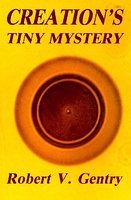| ESA | Return to https://www.halos.com/book/ctm-fwd.htm. | ESA |
An open letter to the readers of Creation's Tiny Mystery:
If I were to follow the unwritten, but commonly understood, guidelines laid down by my fellow evolutionists, many of whom are agnostics like myself, when presented with a book written by a fundamentalist Christian on the topic of "creation," I would ignore the work. Of course, I might kick over the traces a bit, skim through the thing quickly—one must be fair, you know—and then give the document a decent quiet burial in the nearest wastebasket. After all, those among us who have brains in our head instead of rocks—presumably put there by the dead hands of ancient superstition—know that (1) science and religion are immiscible, (2) true scientists cannot be creationists, (3) creationists cannot be scientific, let alone scientists, (4) the last factor is doubled and redoubled—in spades—for fundamentalists, (5) as the good nongray Judge Overton has decreed: there is no science in "creation-science," in fact, (6) those poor—but well-heeled by the radical right—fumblers don't even know what science is. The preceding six commandments—others may be confidently added as time goes on—may be referred to as the A&S Doctrine, in honor of the guiding cosmic luminaries, Isaac Asimov and Carl Sagan.
Fortunately, my scientific education came from teachers who fostered an impertinent curiosity alloyed with a tolerant skepticism. I have news for my evolutionary colleagues: "there are more things in heaven and earth, than are dreamt of in . . ." the A&S Doctrine. Quite apart from the matter of constitutional justice, which has been decisively treated in the works of Cord and Bird, the question of "origins" remains a challenge not only to the human intellect, but also to the human spirit. Creation's Tiny Mystery is a fine documentation of the research of a tenacious, courageous scientist. Robert V. Gentry writes lucidly of his meticulous experimentation with radioactive halos in ancient minerals. Many scientists with international reputations, such as Truman P. Kohman, Edward Anders, Emilio Segre, G.N. Flerov, Paul Ramdohr, Eugene Wigner. E. H. Taylor, etc., have commented favorably in regard to Gentry's integrity and the professional quality [p. xi] of his data. A non- Darwinian evolutionist like me is struck by how often creationists and evolutionists look at the same information, e.g., the fossil record, and extract from it mutually exclusive interpretations.
It is generally believed that science must remain essentially conservative, even "fundamentally conservative" — no pun intended — if its domain is to progress in a nice orderly fashion. This intellectual strategy can lead to an institutionalized bureaucracy of mind, theory, and investigation, that would require a Carroll Quigley to unravel. What are we to think of the chairman of the physics department who urged Gentry to follow a "more conventional thesis problem" that would not lead to an "embarrassment" to the university? Should Svante Arrhenius have played it safely also? Galileo? How many scientists, today, would give up their doctoral work in adherence to a principle? In writing of his struggle to do his own work, to publish his own interpretations that were consistent with his data, Gentry is fighting for academic freedom and intellectual decency for all scientists who defy the established opinion of the day. The investigation of anomalies can be critical to the structure of scientific revolutions, as Thomas Kuhn has suggested.
Creation's Tiny Mystery can be profitably read by all scientists, regardless of their specific discipline, by evolutionists and nonevolutionists alike. Also, it is a challenge to students of government and philosophical thought. Gentry has called into question the practice of science in the institutionalized public arena. Environmental scientists will find Gentry's "young earth model" especially interesting in regard to the problem of nuclear waste confinement. I wonder if his information is being buried somewhere at the bottom of our "tower of Babel" on this problem? Perhaps it is intellectually inconvenient to recognize the potential merit of Gentry's measurements . . . ? In this era of burgeoning governmental waste, it should be encouraging to learn of steps to reduce expenses, even in the research area, but I find it discomforting that "Oak Ridge National Laboratory's budget required marked cutbacks . . ." such as Gentry's $1.00/year subcontract. Methinks this smacks of evolutionary hubris, especially after Gentry's testimony at Little Rock. Hoyle put it rather well in Ossian's Ride: "In science and mathematics, the important thing is what is being said, not who is saying it." Robert V. Gentry is a scientist in the tradition of Galileo. He, his work, and his Weltanschauung do not deserve the premature obituary that my evolutionary colleagues are preparing for it.
| W. Scot Morrow, Ph.D. Professor of Chemistry Emeritus Wofford College |

|
© 2004
Earth Science Associates